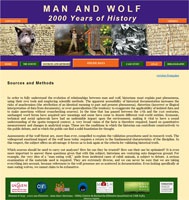RHN 70/2014 | Forum
Professor Jean-Marc Moriceau, Université de Caen Basse-Normandie, CRHQ Axe rural (UMR CNRS 6583)
Website Man and Wolf: 2000 Years of History
A History of the Relationships
Between Man and Wolf
For many centuries, men and wolves lived together on the same territory, engaged in a merciless battle. In European history, wolves were considered man ’s worst enemy, and fear of the animal became embedded in our cultural heritage. France, Spain, Italy, the United Kingdom, and most European states took action against wolves. This hostility and the fear of wolves were mainly caused by their attacks on domestic livestock, which were harmful to many sectors of the economy, even beyond agriculture, up until the 19th century. However, we should not forget that wolf attacks against people themselves were not purely a matter of legend: for a long time, they really did happen. The frequency, and the geographical and temporal distribution of these dramatic incidents varied.
Research so far indicates that the French territory saw numerous tragic incidents of this kind. Although statistically, there were relatively few attacks, their psychological impact was particularly powerful. These aspects of the relationship between man and wolf prompted policies specifically aiming to lessen the “damage”, cut the risks, or simply eradicate these intolerable competitors. Thus, our cultural perception of wolves is based on a long and complex history, which has recently become subject to external influences, since wolves were eradicated.
The website Man and Wolf: 2000 Years of History aims to give the public access to the results of a national study begun in 2002. Firstly, we attempted to measure the real extent of the wolf threat from the Middle Ages to the 20th century, by collecting information on human victims in the territory that is currently France. By using a scientific process to produce university research, and transmitting calls for research from region to region (particularly among historians and genealogists), information on several thousand attacks was recovered. For over half of these, it was also possible to identify the victims and place them in their social and spatial context.
Read more.
Source: Jean-Marc Moriceau
